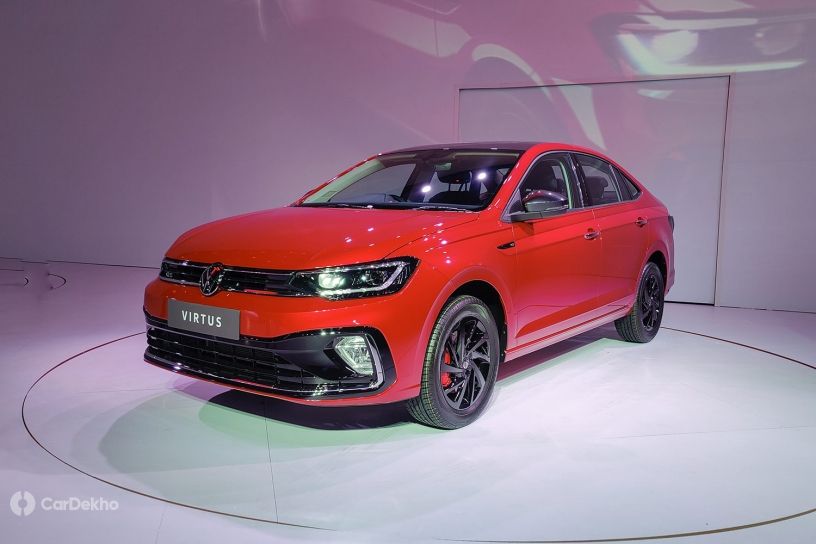Volkswagen Virtus: First Impressions
Modified On Mar 09, 2022 06:10 PM By Arun
- Write a comment
Volkswagen’s Virtus promises a cracker of an experience in the way it looks, feels and what’s under the hood

A replacement to the ageing Vento, and if we’re being technically correct: a glimpse into what the next-gen Polo has to offer — the Virtus has quite the weight on its shoulders. To its credit, it has most bases covered. Let’s take a closer look at Volkswagen’s latest sedan.
Exterior
Volkswagen’s claim of the Virtus being the ‘longest’ sedan in its class isn’t particularly obvious at first glance. The difference is a mere 20mm compared to the Slavia, and a negligible 12mm compared to the Honda City. In every other aspect including wheelbase and ground clearance, the Virtus is identical to the Slavia. What is pretty obvious, however, is that the Virtus is one handsome looking thing. Honey I shrunk the Passat? Baby Jetta? Sure.

On the whole, the Virtus’ design is a lot more cohesive compared to its Skoda sibling. Also, VW has been bolder than usual with their design choices. From the massive piano black accent on the front bumper to the smoked-out tail lamps — there’s quite a lot to absorb and talk about.
LED projector headlights (to be offered as standard) get an L-shaped daytime running lamp that flows straight into the chrome on the grille. Volkswagen has been cheeky here — these might look like double-barrel projectors, but the square element on the inside serves as the turn indicator, and the XL-sized halogen fog lamps and dabs of chrome on the bumper complete the front end.

The sides are practically a cut-paste from the Slavia. The doors, roof and rear quarter panel are shared. However, Volkswagen is quick to point out that the nose slopes a lot more, and the front fender is different to account for the larger bumper. Top-spec versions of the Virtus get 16-inch alloy wheels. The design of the alloys could’ve been a whole lot better, we feel. We’ve seen the same design on a mid-spec Polo Comfortline (albeit a size smaller) for the past couple of years.
The smoked tail lamps, a carryover trait from the Taigun, are the rear end’s piece-de-resistance. Here, too, there’s some tasteful use of chrome on the bumper.
Volkswagen has also done well to establish separate identities in the form of the ‘Dynamic Line’ and the ‘Performance Line’ aka the GT models. These variants get ‘GT’ branding on the grille, front fender and boot. Other additions to the GT variants include gloss black alloy wheels, red calipers, contrast coloured ORVMs and roof and finally, a subtle boot-lip spoiler. We’d have loved to see a pair of dual exhausts stick out of the bumper too!

Before we wrap this section up: a quick note on the colour options. The palette is shared with the Taigun. This means over the usual Candy White, Carbon Steel Grey, and Reflex Silver you get to choose between some seriously eye-popping colours such as the Wild Cherry Red, and Curcuma Yellow. A ‘Rising Blue’ shade is unique to the Virtus.
Interior

Stepping in and out of the Virtus feels natural. Although you have to ‘sit down’ and not ‘walk into’ the cabin, it shouldn’t be a bother for most. On the inside, the Virtus feels like a proper Volkswagen for the most part.
The dashboard has a simple, functionality-first layout. Highlights here include the large slab of piano black, and the contrast-coloured border that envelopes the fascia. We’ve had complaints of less than ideal fit-and-finish on the Slavia, but that’s not the case with the Virtus. While the plastic is hard and there’s no soft-touch material anywhere, the quality is acceptable and the fit seems consistent. There’s scope for improvement too in the quality of the central AC vents and the power window switches. But we’re nitpicking here.
Volkswagen has stuck to a simple beige-black theme for the dash and doorpads. As for the upholstery, the Dynamic Line gets beige-black leatherette upholstery in the top-spec variant, whereas the GT gets full-black upholstery with red stitching.

The seats themselves aren’t any different to what we’ve experienced on the Taigun: heavy on contouring and snug-fitting. This is great for the driver, but not so much for the rear occupants. Added bolstering means the rear bench is best used to accommodate two occupants, not three. The relative lack of width also means squeezing three occupants here is going to be a task. Irrespective, Volkswagen is offering three headrests and proper three-point seatbelts at the rear.
For two, the rear is a happy place to be. There’s enough kneeroom and you can comfortably tuck your feet under the front seats too. Headroom isn’t generous, but should be enough for most. Highlights at the rear include rear AC vents, a central armrest with cupholders and two type-C chargers. If you intend on being chauffeur driven, you might miss roll-up sunblinds for the window.
Boot Space
In this aspect, the Virtus offers a healthy 521litres of space. The rear bench also gets a 60:40 split which should come in handy to carry larger items.
Features

There’s very little unique to the Virtus in terms of features, compared to its stablemates. Basics include:
| Keyless Entry |
Leather-wrapped Steering Wheel |
| Push-button Start |
Leatherette Upholstery |
| Tilt-Telescopic Steering Adjust |
Wireless Phone Charging |
| Height-adjustable Driver’s Seat |
Automatic Headlamps |

Highlights on the top trims feature an 8-inch digital driver’s display, 10.1-inch touchscreen with wireless Android Auto and Apple CarPlay, ambient lighting and ventilated seats.
Engine Options

Volkswagen will be sticking to their turbocharged petrol engines for the Virtus. A 1-litre, three-cylinder motor and a 1.5-litre, four-cylinder motor will be on offer. A 6-speed manual will be available with both. If you’re considering an automatic, the 1-litre engine will be offered with a 6-speed automatic, whereas the 1.5-litre engine will get a 7-speed DSG option.
Both engines get idle-start stop tech to save fuel. The 1.5-litre engine goes a step further with cylinder deactivation technology: shutting down two cylinders under low load conditions. Whether this makes up for Volkswagen’s decision to axe the TDI diesel engine remains to be seen.
Verdict

Pre-launch bookings are currently open. We’re expecting prices to be more or less on par with the Slavia, in the Rs 10-18 lakh (ex-showroom) space. Volkswagen’s Virtus feels well-built, has the right amount of space and features and promises some fun too. All the Virtus needs to do now is actually impress with its on-road manners. That way, it will be cashing in on all the cheques that the brochure is writing.















